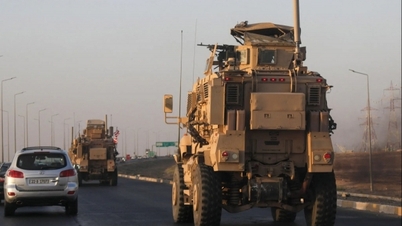Shocking revelations from the “Walls of Jericho”
The roughly 40-page document, codenamed “The Wall of Jericho” by the Israeli government, outlined point-by-point the exact attack that Hamas then carried out on October 7, resulting in the deaths of some 1,200 people.

An Israeli tank was captured by Hamas militants during an attack on October 7. Photo: Foreign Policy
According to documents released by The New York Times, Hamas did not set a date for the attack, but described a methodical offensive designed to overwhelm fortifications around the Gaza Strip, capture Israeli cities and strike key military bases, including the headquarters of a regular Israeli army division.
Hamas followed the detailed plan with astonishing precision. A “storm” of rockets rained down on Israeli territory at the start of the offensive; the use of drones to destroy security cameras and automatic gun systems along the border; Hamas fighters entering Israeli territory by paraglider, on motorcycles, and “on foot” – all of these descriptions occurred on October 7.
The document was widely circulated among Israeli military and intelligence leaders, but Israeli experts determined that an attack of such scale and ambition was beyond Hamas' capabilities, according to the New York Times. It is unclear whether Prime Minister Benjamin Netanyahu or other top political leaders in Tel Aviv have seen the document.
Last year, shortly after obtaining the document, officials from the Israeli army’s Gaza Division, which is responsible for guarding the border with the Gaza Strip, said Hamas’s intentions were unclear. “It remains unclear whether the plan has been fully accepted and how it will be implemented,” a military assessment found in the “Jericho Walls” read.
Then, in July, just three months before the attacks, a veteran female analyst with Unit 8200, Israel’s information intelligence agency, warned that Hamas had conducted a high-intensity, all-day exercise that appeared to be similar to what was outlined in the detailed plan.
But a colonel in the Gaza Division dismissed those concerns, according to encrypted emails reviewed by The New York Times. “I completely reject the argument that this scenario is a fantasy,” the analyst wrote in an email. The Hamas exercise, she said, fit “the context of the Jericho Walls… It was a plan designed to start a war. This was not just a raid on a village.”
Pay dearly for mistakes
Israeli officials acknowledge that if the military had taken these warnings seriously and sent significant reinforcements south, where Hamas attacks, Israel could have scaled back the attacks or even stopped them. Instead, the Israeli military was caught off guard as Hamas fighters poured out of Gaza. As a result, October 7, 2023, became the deadliest day in Israeli history.
Israeli security officials have admitted they failed to protect the country, and the government is expected to set up a commission to investigate the events leading up to the attacks. The “Jericho Walls” documents expose a series of mistakes spanning years that culminated in the October 7 attack, which is considered the worst failure of Israeli intelligence since the surprise attack that led to the 1973 Arab-Israeli war.

Hundreds of Hamas rockets from the Gaza Strip were launched into Israeli territory. Photo: Reuters
At the heart of all these failures is an inaccurate and deeply mistaken belief that Hamas lacks the capability to attack and would not dare to do so. Officials interviewed by the New York Times said that belief was so ingrained in many members of the Israeli government that they ignored the mounting evidence.
Israeli officials have not said how they obtained the “Walls of Jericho” document, but it is among several versions of the attack plan that have been compiled over the years. For example, a 2016 Israeli Defense Ministry memo obtained by the New York Times also states: “Hamas intends to move the next confrontation to Israeli territory.” Such an attack would likely involve hostage-taking and “occupation of one (and possibly even several) Israeli communities,” the memo reads.
The “Jericho Walls” document, named after the ancient fortifications in what is now the West Bank, is even more explicit, detailing rocket attacks to distract Israeli soldiers and rush them into shelters, and the use of drones to neutralize elaborate security measures along the border fence separating Israel and the Gaza Strip.
Hamas fighters would then breach 60 points on the wall, storming across the border into Israel. The document begins with a quote from the Quran: “Surprise them by entering the gate. If you do, you will surely prevail.” The same phrase has been widely used by Hamas in its videos and statements since October 7.
Worst defeat in 75 years
The documents compiled in the “Jericho Walls” also include details on the location and size of Israeli military forces, communications centers and other sensitive information, raising alarming questions about how Hamas gathers intelligence and raising suspicions of leaks within Israel’s security establishment.

Hamas gunmen seize an Israeli military vehicle after infiltrating the country during an attack on October 7. Photo: Reuters
One of the most important targets listed in the document was to attack the Israeli military base in Re'im, which houses the Gaza Division, the unit responsible for defending the area. Other bases under the command of this division are also listed in the “Jericho Walls”. Hamas carried out that goal on October 7, attacking Re'im and overrunning parts of the base.
The plan's audacity made it easy to underestimate, officials said. All militaries write plans they never use, and Israeli officials estimate that even if Hamas were to mount an attack, it could muster only a few dozen men, not hundreds.
Israel has also been distracted by other moves by Hamas, which, shortly before the attack, was negotiating permits for Palestinians to work in Israel, which officials in Tel Aviv saw as a sign that Hamas did not want war.
That misjudgment cost Israel dearly, as Hamas eventually launched an unprecedented attack that would go on to become one of the worst miscalculations in the 75-year history of the Jewish State.
Nguyen Khanh
Source



![[Photo] Prime Minister Pham Minh Chinh chairs the second meeting of the Steering Committee on private economic development.](https://vphoto.vietnam.vn/thumb/1200x675/vietnam/resource/IMAGE/2025/11/01/1762006716873_dsc-9145-jpg.webp)










































































































Comment (0)